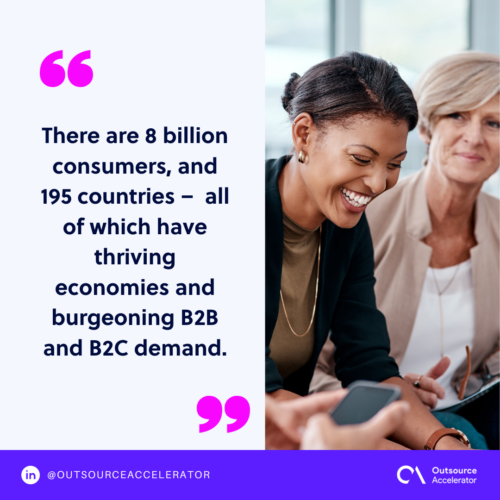Default global: Global is the new black

Andreessen Horowitz, the preeminent Silicon Valley VC, recently made the case for companies having a “default global” mindset from day one, in terms of systems, operations, and reach.
In the good ol’ days, the default global model would require massive investment, ensuring that only the big boys could play on the global stage. The old ‘Multinational Corporation’ moniker was the reserve of the elite enterprise.
But going default global is no longer just for multinationals.
With advancements in technology, platforms, and behaviors, even micro startups can be default global players.
Default global
The reason for going global early is self-evident.
The Andreessen Horowitz team noted, “Why limit your potential client base to a mere city, state, or country, when the whole world is now within reach?” There are 8 billion consumers, and 195 countries – all of which have thriving economies and burgeoning B2B and B2C demand.
So, how to build a default global empire?
It’s no longer just about what products you ship or what services you can provide.
The focus is on three key elements: Talent, customers, and systems.

Default global element #1: Talent beyond your own backyard
Remote work is no longer a trend. It’s a way of life, as claimed by experts at Andreessen Horowitz.
With default globalization, companies have access to the largest pool of talent imaginable.
More than ever, it is not only feasible but economically viable to create and manage a team from across the globe.
This is the era of the borderless empire. Roles are no longer bound by geography.
Regardless of their size, organizations can seize the very best candidates from virtually anywhere on the planet, with around-the-clock productivity and access to diverse skills/ideas leaving customers better served than ever before.
Default global element #2: Universal customer reach
There was a time before when your customer base was shackled to your geographical location.
But those times have changed.
Developed countries are rapidly moving from product-based economies to service-based economies, many of which are digital – think Facebook, Netflix, JPMorgan, Microsoft, and Zoom.
Default global element #3: B2B and B2C customers are becoming increasingly homogenized
Consumers and businesses feed from the same news, entertainment, and information sources, aligning in terms of their preferences and behaviors.
And services are distributed much more easily than physical products – they are essentially borderless by nature.
This is evident by the globalized cloud-based platforms (Salesforce), social media channels (TikTok), app stores (Android), and forums (Reddit) …all available to anyone, anywhere, at any time.
Default global element #4: Services without borders
Infrastructure no longer means towering buildings, concrete highways, and brutalist power stations.
Supporting this global shift, companies’ needs are met without leaving home.
Need a worldwide storefront? Shopify.
Easy payments? Stripe.
Complex transfers? Wise and Airwallex.
The turnkey conduits used by companies to grow and expand beyond their physical borders are unprecedented.

Brave new world
Today, a teen can safely connect with a Chinese manufacturer, set up a Shopify store, build a TikTok audience, drive Instagram sales, and manage shipping all from home.
Their business is default global. What’s holding you back?
Question for your business…
How are you going to unlock the default global goldmine?







 Independent
Independent




